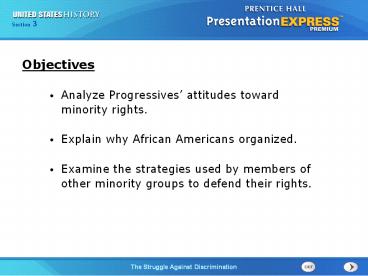Objectives - PowerPoint PPT Presentation
1 / 20
Title:
Objectives
Description:
Examine the strategies used by members of other minority groups to defend ... opposed Washington s approach; favored education in history, literature, and ... – PowerPoint PPT presentation
Number of Views:63
Avg rating:3.0/5.0
Title: Objectives
1
Objectives
- Analyze Progressives attitudes toward minority
rights. - Explain why African Americans organized.
- Examine the strategies used by members of other
minority groups to defend their rights.
2
Terms and People
- Americanization effort to replace immigrant
customs with white, Protestant, middle-class
practices and values - Booker T. Washington favored a gradualist
approach for blacks to earn rights through
economic progress and employment in the
skilled trades - W.E.B. Du Bois demanded immediate and full
rights for blacks as guaranteed by the
Constitution
3
Terms and People (continued)
- Niagara Movement opposed Washingtons approach
favored education in history, literature, and
philosophy, not just in the trades - NAACP National Association for the Advancement
of Colored People, viewed full legal rights
as the only solution to racial discrimination - Urban League organization to assist
working class African Americans with relief,
jobs, clothing, and schools
4
Terms and People (continued)
- Anti-Defamation League organization to defend
Jews and others from false statements, and
verbal or physical attacks - mutualistas Mexican American groups that
provided loans, legal assistance, and disability
insurance for members
5
What steps did minorities take to combat social
problems and discrimination?
Prejudice and discrimination continued even
during the Progressive era. Minorities, including
African Americans, Latinos, Catholics, Jews, and
Native Americans, worked to help themselves.
Their efforts paved the way for the era of
civil rights several decades later.
6
Most Progressives were white, middle-class
Protestants who held the racial and ethnic
prejudices common in that era.
They envisioned a model America based on
Protestant ethics and a white middle-class
lifestyle.
As a result, they were often hostile to minority
or immigrant cultures.
7
Progressives believed assimilation would turn
immigrants into loyal and moral citizens.
- The results were well-intentioned, but often
insensitive or racist efforts to change the
immigrants. - While teaching English they also advised
immigrants to replace their customs with
middle-class practices and Protestant values. - Settlement houses and other civic groups played a
prominent role in Americanization efforts.
8
Progressives saw many immigrant customs as moral
failures.
This prejudice against immigrant customs and
culture gave strength to the temperance movement.
Immigrant use of alcohol, such as the serving of
wine with meals, alarmed some people.
9
Racial theories were also used to justify laws
that kept blacks from voting. Many Progressives
supported racial prejudices.
- The Plessy v. Ferguson decision furthered
discrimination in the North as well as the South. - By 1910, segregation was the norm nationwide.
- In 1914, even federal offices were segregated by
Progressive President Woodrow Wilson.
10
African Americans were split over how to end
racial discrimination.
Booker T. Washington urged a patient, gradual
effort based on earning equality through training
and work in the skilled trades.
W.E.B. DuBois demanded that African Americans
receive all constitutional rights immediately.
11
In 1905, DuBois and William Monroe Trotter were
concerned that all across the South, black men
could not vote.
- Their Niagara Movement rejected the gradualist
approach stating that trade skills create
workers, but cannot make men. - They also believed African Americans should learn
how to think for themselves through the study of
history, literature, and philosophy.
12
After a 1908 riot against African Americans in
Springfield, Illinois, a number of white
Progressives joined together with the Niagara
Movement to help form the NAACP.
13
The NAACP aimed to help African Americans become
physically free from peonage, mentally free from
ignorance, politically free from
disfranchisement, and socially free from insult.
The NAACP or National Association for the
Advancement of Colored People was founded to
demand voting and civil rights for African
Americans.
14
The NAACP attracted prominentProgressives to
their cause.
Supporters Their tactics
Jane Addams Ray Stannard Baker Florence Kelley Ida B. Wells used their newspapers to publicize the horrors of race riots and lynchings. used the courts to challenge unfair housing laws. promoted professional careers for African Americans.
15
In 1911, the Urban League was formed to create a
network of local clubs and churches to assist
African Americans migrating to northern cities.
While the NAACP focused on political justice, the
Urban League helped the poor find jobs, housing,
clothing, and schools for their children.
16
Many ethnic groups formed self-help organizations
to combat prejudice and protect their rights.
African Americans NAACP
Jews Bnai Brith
Mexican Americans Mutualistas
Native Americans Society of American Indians
17
In 1843, Jewish families formed the Bnai Brith
to provide religious education and self-help. In
1913, the Anti-Defamation League was formed to
defend against physical and verbal attacks, false
statements, and to secure justiceand fair
treatment for all citizens alike.
18
Mexican Americans formed mutualistas, groups that
provided legal assistance and disability
insurance.
The Partido Liberal Mexicano in Arizona served a
role similar to the Urban League for Mexican
Americans. Many Latinos were subject to unfair
labor contracts, which the mutualistas helped to
defeat.
19
Despite organized protests, Native Americans and
Japanese lost their ownership of land.
In 1913, California restricted land ownership to
American citizens only, which excluded the
Japanese, who were not allowed to become
citizens. In a 1922 decision, the Supreme Court
allowed the limitation.
In 1911, Carlos Montezuma helped form the Society
of American Indians to protest federal policy.
Nevertheless, by 1932, two-thirds of all tribal
lands had been sold off.
20
Section Review
QuickTake Quiz
Know It, Show It Quiz

